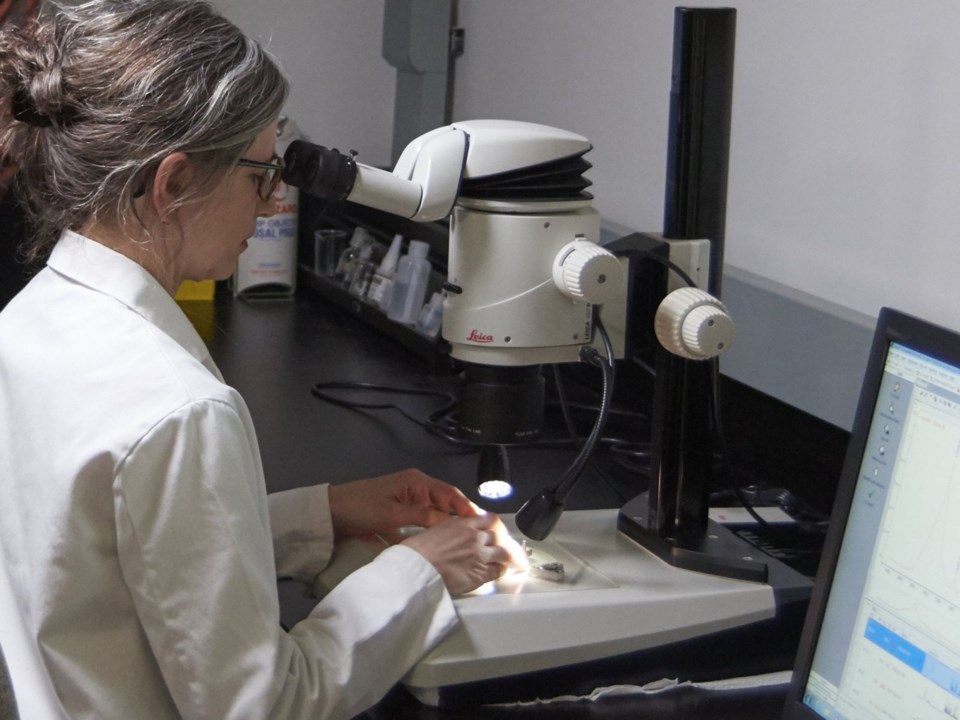Research undertaken at the Canadian Light Source (CLS) at the University of Saskatchewan was key to understanding how to conserve experimental oil paintings by Rita Letendre, one of Canada’s most respected living abstract artists.
The work done at the CLS was part of a collaborative research project between the Art Gallery of Ontario (AGO) and the Canadian Conservation Institute (CCI) that came out of a recent retrospective Rita Letendre: Fire & Light at the AGO. During close examination, Meaghan Monaghan, paintings conservator from the Michael and Sonja Koerner Centre for Conservation, observed that several of Letendre’s oil paintings from the fifties and sixties had suffered significant degradation, most prominently, uneven gloss and patchiness, snowy crystalline structures coating the surface known as efflorescence, and cracking and lifting of the paint in several areas.
Kate Helwig, Senior Conservation Scientist at the Canadian Conservation Institute, says these problems are typical of mid-20th century oil paintings. “We focused on three of Rita Letendre’s paintings in the AGO collection, which made for a really nice case study of her work and also fits into the larger question of why oil paintings from that period tend to have degradation issues.”
Growing evidence indicates that paintings from this period have experienced these problems due to the combination of the experimental techniques many artists employed and the additives paint manufacturers had begun to use.
In order to determine more precisely how these factors affected Letendre’s paintings, the research team members applied a variety of analytical techniques, using microscopic samples taken from key points in the works.
“The work done at the CLS was particularly important because it allowed us to map the distribution of materials throughout a paint layer such as an impasto stroke,” Helwig said. The team used Mid-IR chemical mapping at the facility, which provides a map of different molecules in a small sample.
For example, chemical mapping at the CLS allowed the team to understand the distribution of the paint additive aluminum stearate throughout the paint layers of the painting Méduse.
This painting showed areas of soft, incompletely dried paint, likely due to the high concentration and incomplete mixing of this additive.
The painting Victoire had a crumbling base paint layer in some areas and cracking and efflorescence at the surface in others. Infrared mapping at the CLS allowed the team to determine that excess free fatty acids in the paint were linked to both problems; where the fatty acids were found at the base they formed zing “soaps” which led to crumbling and cracking, and where they had moved to the surface they had crystallized, causing the snowflake-like efflorescence.
AGO curators and conservators interviewed Letendre to determine what was important to her in preserving and conserving her works, and she highlighted how important an even gloss across the surface was to her artworks, and the philosophical importance of the colour black in her paintings. These priorities guided conservation efforts, while the insights gained through scientific research will help maintain the works in the long term.
In order to restore the black paint to its intended even finish for display, conservator Meaghan Monaghan removed the white crystallization from the surface of Victoire, but it is possible that it could begin to recur.
Understanding the processes that lead to this degradation will be an important tool to keep Letendre’s works in good condition.
“The world of modern paint research is complicated; each painting is unique, which is why it’s important to combine theoretical work on model paint systems with this kind of case study on actual works of art” said Helwig. The team hopes to collaborate on studying a larger cross section of Letendre’s paintings in oil and acrylic in the future to add to the body of knowledge.
Helwig, Kate, Meaghan Monaghan, Jennifer Poulin, Eric J. Henderson, and Maeve Moriarty. "Rita Letendre’s Oil Paintings from the 1960s: The Effect of Artist’s Materials on Degradation Phenomena." Studies in Conservation (2020): 1-15. DOI: 10.1080/00393630.2020.1773055.



